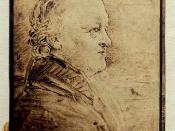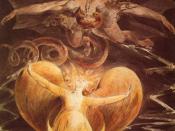A Big Lesson from Little Things
William Blake's "The Clod and the Pebble" presents its readers with what seems to be, at first glance, a debate concerning love. Upon closer examination, however, a reader comes to understand that there is much more than a debate on love within this significant work. Blake allows the opposing philosophies of the Clod and the Pebble to become more apparent by the way he structures this poem in three stanzas, mainly composed in iambic tetrameter. The first and last stanzas present the reader with dialogue that reflects the views of the title characters. By what they say, the reader comes to see how the Clod and the Pebble differ in their respective senses of purpose in the world. The middle stanza serves to separate the two views while further contrasting the attitudes of the Clod and the Pebble. Blake's diction and personification of the Clod and the Pebble, along with his personification of the abstract concept of Love, help the reader grasp the philosophies of these ordinarily insignificant objects.
In this work, William Blake touches on ideas beyond the scope of love as he also explores ideas concerning one's personal values and fulfillment in life. Through the words of the Clod and the Pebble, Blake hints at the fact that countless people wander through life wondering what their place in the universe is. Many have trouble accepting their stations, if they should actually find them. "The Clod and the Pebble" helps to affirm the fact that one must remain open-minded and accept his place in the world in order to make the most out of his life.
The Clod's view of love and his inherent optimistic view of his own life, in spite of the difficulties he faces, form the...


